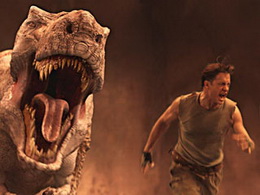This is part of Eric’s live coverage of the Siggraph 2008 Festival in Los Angeles as it appears on DigitalContentProducer’s LiveBlog. Check it out for the full details and all of Eric’s articles.
 “Live-action 3D is the future/Teach it well and let it lead the way,” Whitney Houston once sang, I believe. Oops, wrong bad joke. The big joke among people who make 3D stereoscopic films is that it is way more work than making a regular 2D film because you have to make the same film twice.
“Live-action 3D is the future/Teach it well and let it lead the way,” Whitney Houston once sang, I believe. Oops, wrong bad joke. The big joke among people who make 3D stereoscopic films is that it is way more work than making a regular 2D film because you have to make the same film twice.
This summer’s Journey to the Center of the Earth was shot in stereo with dual Sony HDC-950 HD cameras mounted on Pace Technologies‘ 3D HD rigs. The movie’s Visual-Effects Supervisor Christopher Townsend was on hand to explain that there is no cheating space when you’re filming live-action 3D. You can’t use any of the solutions normally associated with 2D movies, such as flat matte paintings for backgrounds, 2D compositing, or any 2D cueing traicks at all. Journey to the Center of the Earth is the directorial debut of longtime visual-effects supervisor Eric Brevig and the movie was the first ever full-length stereoscopic motion picture shot in HD to be released in digital 3D.
Townsend made our eyes hurt in his demonstration. A lot. In illustrating the challenge of making good 3D that is dynamic and easy on the eyes, he showed some examples of bad 3D. Stereo occlusion and mismatched left/right focus scenes of Brendan fraser swimming were enough to strain the eyes and hurt the brain. Since Hollywood doesn’t release any 3D without a serious attention to detail and quality, it was kind of cool to realize what 3D theater viewing would be like if it wasn’t done correctly. Over an extened period of time in a full-length film, I can see the brink madness being on the horizon.
Speaking of madness, there comes a time when you just get sick and tired of putting the glasses on and taking them off over and over again. “Here’s one example,” Townsend would say, “Please put your glasses on.” Ten seconds later, the lights come up and he brings up another topic. Then its lights down, glasses on again for another example. It’s a good thing most 3D movies require the use of the glasses throughout the entire film because when I’m engrossed in the complicated moral dilemmas of a Brendan Fraser movie, I don’t want to be thinking about my 3D specs the whole time. Of course, this being Siggraph, our glasses were the coolest of the cool. The staff handed out some pretty stylish Ray-Ban-looking 3D glasses, so the conference hall was filled with an army of Risky Business-era Tom Cruises all moving their arms in sync.
Townsend echoed his colleagues’ enthusiasm for the burgeoning new format, which seems to be just on the bubble with catching on in a mainstream way every year when he says that the transition from 2D filmmaking to 3D filmmaking will someday be looked at historically. “It will be as important as the transition from silent to sound or black-and-white to color,” he says.
An impressive clip from U2 3D was shown by that film’s Visual Effects and Imaging Supervisor, David Franks, who commented on the need for immersive surround sound. Also, a strange and wonderful Bjork music video for “Wanderlust” was shown by its creators (known as Encyclopedia Pictura) that blended CGI effects with puppetry and live action. A 7ft. long beast with three people inside of it was shot on greenscreen to blend with a colorful “river god” and waterfalls that flowed like long strands of rope. This completely misses the point of this panel, but you view the entire video here.
Is stereo worth all the extra trouble? Townsend says yes, that the technology won’t just be used for action movies in the near future. Live-action 3D should totally immerse you in the story, which is why he went so far as to say that he looks forward to the 3D version of My Dinner With Andre. A 3D image of Wallace Shawn burned in my brain for 90 minutes? Now that’s scary.








Comments on this entry are closed.